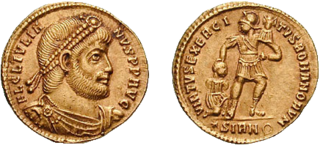
AD 66 (LXVI) was a common year starting on Wednesday of the Julian calendar. At the time, it was known as the Year of the Consulship of Telesinus and Paullinus. The denomination AD 66 for this year has been used since the early medieval period, when the Anno Domini calendar era became the prevalent method in Europe for naming years.

Legio quarta Scythica was a legion of the Imperial Roman army founded c. 42 BC by the general Mark Antony, for his campaign against the Parthian Empire, hence its other cognomen, Parthica. The legion was still active in Syria in the early 5th century.

Legio IX Hispana, also written Legio nona Hispana or Legio VIIII Hispana, was a legion of the Imperial Roman army that existed from the 1st century BC until at least AD 120. The legion fought in various provinces of the late Roman Republic and early Roman Empire. It was stationed in Britain following the Roman invasion in 43 AD. The legion disappears from surviving Roman records after c. AD 120 and there is no extant account of what happened to it.
A thunderbolt is a symbolic representation of lightning when accompanied by a loud thunderclap.

Lucius Neratius Marcellus was an imperial Roman military officer and senator who held a number of posts in the Emperor's service. Marcellus was elected consul twice, first under Domitian in 95 AD and again under Hadrian in 129. His life provides several examples of how patronage operated in early Imperial Rome.

An aquila was a prominent symbol used in ancient Rome, especially as the standard of a Roman legion. A legionary known as an aquilifer, or eagle-bearer, carried this standard. Each legion carried one eagle.

Legio X Fretensis was a legion of the Imperial Roman army. It was founded by the young Gaius Octavius in 41/40 BC to fight during the period of civil war that started the dissolution of the Roman Republic. X Fretensis is then recorded to have existed at least until the 410s.

The Battle of Bibracte was fought between the Helvetii and six Roman legions, under the command of Gaius Julius Caesar. It was the second major battle of the Gallic Wars.

Legio undecima Claudia was a legion of the Imperial Roman army. XI Claudia dates back to the two legions recruited by Julius Caesar to invade Gallia in 58 BC, and it existed at least until the early 5th century, guarding lower Danube in Durostorum. The emblem of the legion is not known; it could have been, as all of the Caesar's legions, the bull or possibly the she-wolf lactating the twins.
Arnouphis or Harnuphis was an Egyptian who, according to Dio Cassius, saved the Roman legion XII Fulminata during a campaign against the Quadi in about AD 172 by calling up a rainstorm. Dio Cassius calls Arnouphis a magos, originally a term for Zoroastrian priests. David Frankfurter says that Arnouphis was an Egyptian priest, but he was called a magos because Romans regarded priests from many Near Eastern cultures as fitting a single stereotype of exotic magicians.

Ramana also spelled Ramany, Romana, is an urban-type settlement and municipality in Azerbaijan, within the Sabunchu raion of Baku. Population (2005): 8,800.

Gaius Julius Quadratus Bassus (70–117), was a Roman senator and general. He rose from provincial aristocratic origins to occupy the highest offices of Rome. He served as a legionary commander and as imperial governor of Judea, Cappadoccia, Galatia, Syria and Dacia. He is known to have been active under Trajan in the Dacian and Parthian Wars. Bassus was suffect consul in the nundinium of May–August 105 with Gnaeus Afranius Dexter as his colleague.

This article discusses the Roman influence in Caucasian Albania.
Cretan archers were a well known class of warrior whose specialist skills were extensively utilized in both ancient and medieval warfare. They were especially valued in armies, such as those of the Greek city states, Macedonia and ancient Rome, which could not draw upon substantial numbers of skilled archers from their native populations.

The vine staff, vine-staff, or centurion's staff was a vinewood rod of about 3 feet (1 m) in length used in the ancient Roman Army and Navy. It was the mark and tool of the centurion: both as an implement in the direction of drill and maneuvers; and to beat wayward or laggard soldiers or sailors under his command. It was also borne by evocati who held an equivalent rank.
Fulminatrix may refer to:









